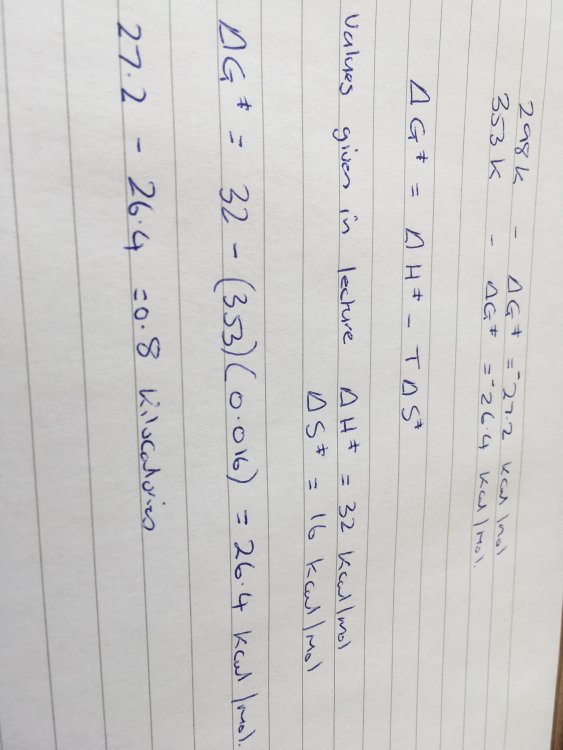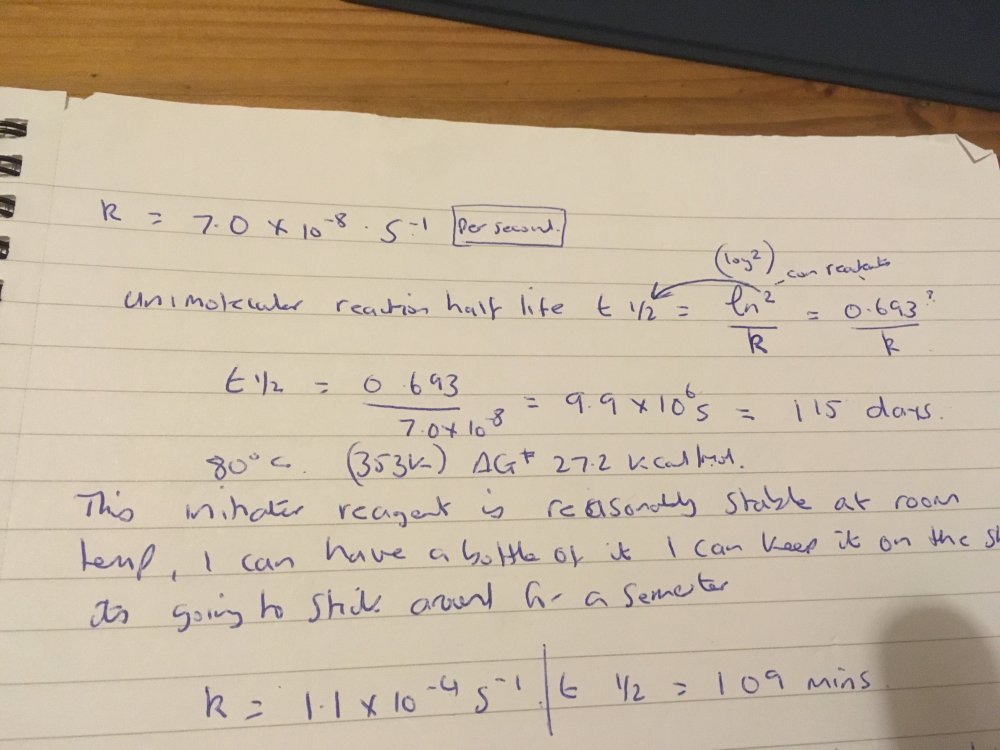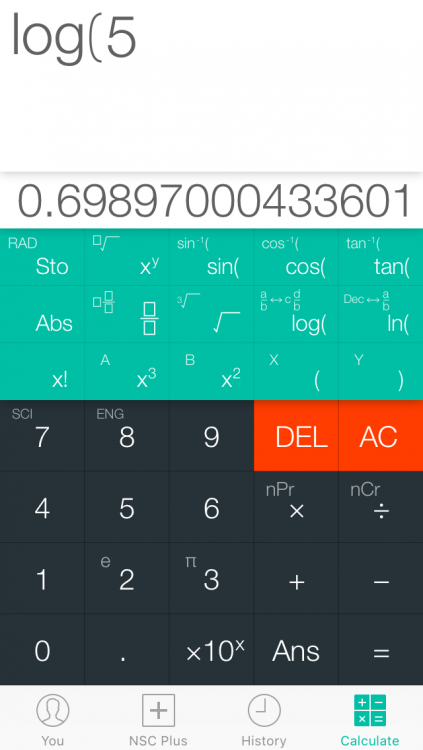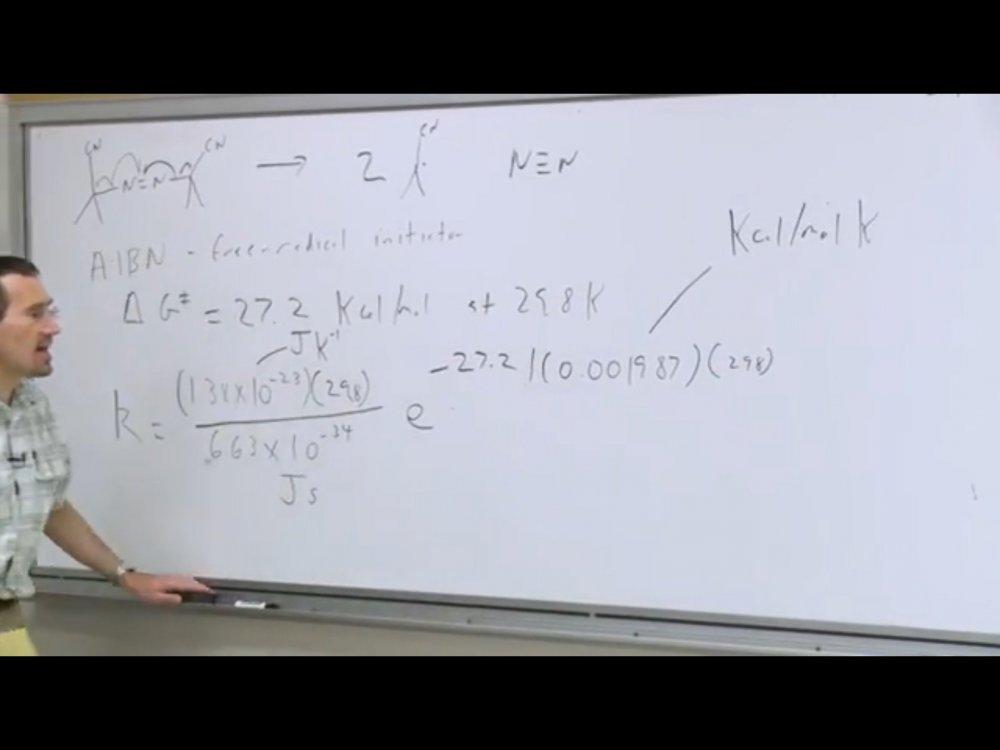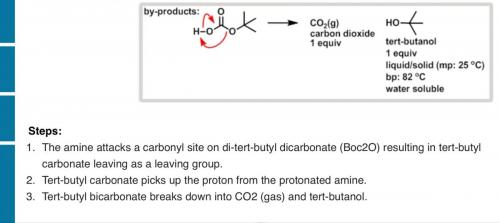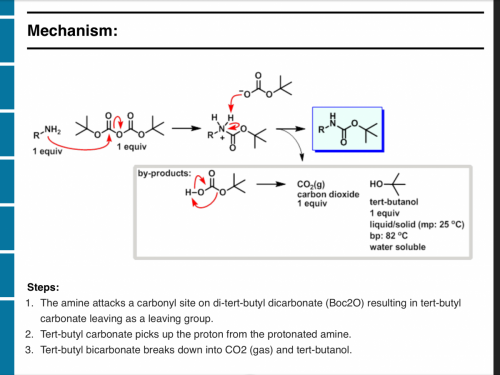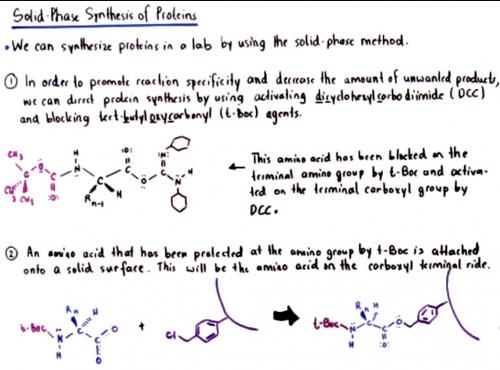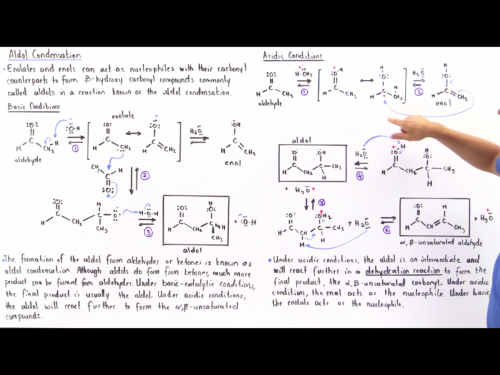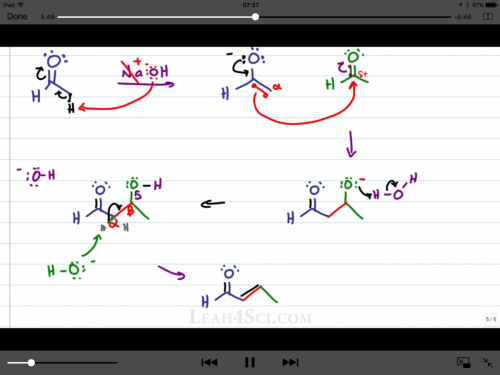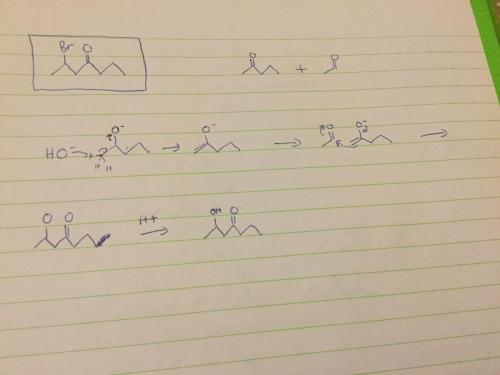-
Posts
29 -
Joined
-
Last visited
Content Type
Profiles
Forums
Events
Everything posted by Sciencegeeknm
-
Hi, I have another question. From the attachment you can see that at 298 k the delta G is 27.2 and at 353 it is 26.4 There is a difference of 0.8 Kcal. The lecturer says that 0.8 then gives you 0.016 and he has 16 Kcal as the delta S value. Why does 0.8 then give you 0.016? I don’t understand.
-
Thanks! Now I understand.
-
Thanks. Yes using brackets does work better. Once you find the rate it can be used to find the half life of the reactant. I was just wondering on the screenshot attached where the value of 0.693 comes from? Something to do with log2? If I press log and enter 5 a value near to 0.693 is displayed ?
-
Thank you for sending the photo showing your workings. It really helped and now I can reach the right answer using your values and the ones quoted in the lecture. My mistake when doing the RHS of the equation was to divide and multiply the values all in one go. You first have to multiply the gas constant by the temperature and then divide top by bottom. 2 separate steps. You then get 45.94. Then ex 45.94 to get 1.12 ^-20 Then 6.203^12 x 1.12^-20= 0.0000000694736 After some rounding up 7.0^-8 Thanks again for your help. I will now have a better understanding when approaching other equations that come up in the lectures.
-
I know that k is the reaction rate to be solved and kb is the Boltzman constant. The screenshot attached is from the actual lecture. I really have no idea how to use the values given to reach the answer Can you tell me how you reached the correct answer? Sorry to be a pain Thanks
-
Do you have to use the whole equation to reach the reaction rate of 7.0 x10-8? What do You mean when you say the Boltzman constant belongs on the right hand side of the equation? Thanks.
-
Yes it does. I am entering 1.38 ^-23 x 298 = 4.1124 ^-21 divided by 6.63 ^-34 = 6.2027^12 then pressed ex button and entered -27.2 divided by 1.987^-3 x 298 = 2.30x10-7 ?? The answer should be in per seconds. The joules cancel out so is it a kelvin to s-1 conversion? Thanks for your help so far.
-
Thank you. I'm not sure of what steps to use on a calculator. Can you provide more detail? This is not a homework question just a lecture I watched on YouTube. Thanks.
-
I am entering 1.38 x (EE) -23 x 298= 4.1124e-21 divide by 6.63 x 10-34= 6,202,714,932,126.697 Then -27.2 divide by 0.001987 x 298k ?? Then do you multiply one side of the equation with the other? My answers are way off.
-
Hi hypervalant_iodine, i am entering 1.38 (EE button) -23 x 298 and then divide by planks constant. But I get a really large number. Can you send a breakdown of each calculation step you are doing to arrive at the answer? Many thanks.
-
In a lecture I recently watched there was an example of using the Eyring equation. I have attached a picture showing the values plugged into the equation. The activation energy is 27.2 and the temperature used is 298 K. The answer given in the lecture is 7.0 x 10-8 for the reaction rate. I have tried to work this out on a calculator but can't get the answer given? Maybe I am multiplying the wrong values together. I found an online calculator tool which came to the same answer(2nd screenshot attached) Any help would be appreciated.
-
Hi Everyone, I have been looking into the world of octahedral organometallic complexes Molybdenum hexacarbonyl is a white colour and is a d6 compound. The carbonyl ligands are classsed as strong field so would induce a large octahedral splitting of the d orbitals resulting in low spin In low spin the six electrons would completely fill up the 3 t2g orbitals and there would be no unpaired electrons I am right in thinking that because there are no unpaired electrons to make a transition up into the eg orbitals after a photon of light is added, no colour frequency of light is absorbed and therefore all colours are reflected back as white or colourless? Kind Regards Nick.
-
I am a bit confused as to how to assign oxidation states to metal ligand complexes. why does the titanium in Ti(NMe2)4 have an oxidation state of +4 but the platinum in Pt(NH3)4 has a +2 oxidation state? Do you need to know how many valence electrons the metal atom has first? Thanks Nick.
-
On the attached file I have tried to work out the reaction pathway. The reaction given at the top is from a chemistry lecture I watched but no mechanism was given. In the first mechanism I just reacted one of the N20 molecules with hydroxide. The hydroxide attaching to the Nitrogen and is then deprotenated by the second OH- I now have H20 and N03- but it doesn't explain how the second N20 molecule ends up with a second electron on the Nitrogen. In the second mechanism (which I think is correct) the 2 N20 molecules join together to form the dimer N2O4. OH- attacks the anti bonding orbital of the Positive Nitrogen and the 2 electrons from the N-N bond go onto the other N20 molecule. The OH attached is now deprotenated by the second OH- to leave H20,N03- and of course a lone pair on the Nitrogen. It would be great if someone could verify the second mechanism as correct . Regards Nick
-
Sorry, I didn't mean how does the carboxylate remove the proton from nitrogen, I was referring instead to the Tert-butyl bicarbonate molecule in the by- products box. I was wondering why the oxygen attached to the tert-butyl group deprotanates the OH and starts the decarboxylation reaction?
-
Ok, now I understand. The first amino acid is joined to the linkage unit by way of subsitution reaction so no activation needed. I have attached a screenshot showing the mechanism showing how the boc group is added. step 3 says that the tert butyl bicarbonate breaks down into CO2 and tert butanol. What causes the ester oxygen to grab the hydrogen? Would this reaction require heat?
-
Thanks for your reply it really helped.
-
-
In the attached photo, step one has the amino acid N terminus blocked and the C terminus activated by DCC. In step 2 the amino acid does not show the DCC unit. Would it not be needed in order to attach the amino acid to the linkage molecule? Also, what reaction takes place when joining the C terminus to the benzyl chloride linkage unit. I can see that the Cl is substituted for the oxygen so would this go via SN2 or SN1? Thanks for your help. Nick.
-
Ah ok. Stabilisation through resonance. So would it ever be SN2?
-
Interesting that you say SN1 as the teacher says this would go by SN2 alkylation. If it went by SN1 then you get a primary carbocation?
-
-
Hi, The following reaction(see photo attached) was talked about on a lecture I watched on YouTube. There was no mechanism mentioned so I tried to work it out myself. Can you confirm if I'm on the right track? Firstly the Na H (in excess) would de protonate all of the OH groups on the glucose molecule. Then the now O- groups would react by SN2 pathway on the benzyl chloride molecules. Now all the former O- groups would be joined to benzyl CH2 units? Thanks. Nick.
-
Hi, I'm just learning the Aldol Condensation mechanism and in one video it's says under basic catalytic conditions the final product is usually the Aldol. Only under acidic conditions will the Aldol react further to form the a,b unsaturated compound. But on another video (by a different person) she says that by adding heat you can do the condensation under basic conditions as a molecule of OH- will deprotanate the alpha proton forming a pi bond between the alpha and beta carbons and kicking off the OH group. The first video must be wrong in saying that under basic conditions you stop at the Aldol product? I'm not planning to do this reaction just learning it out of interest. Any advice would great as the two videos seem to be telling me different things? I have attached screenshots from the two videos.
-
Thanks for your suggestion of using the Adol reaction. On the attached file I have drawn out the reaction which I think is correct? You said to substitute the OH for Br. Would you use H-Br and would the reaction follow the Sn1 pathway with water as the leaving group? Many thanks.



